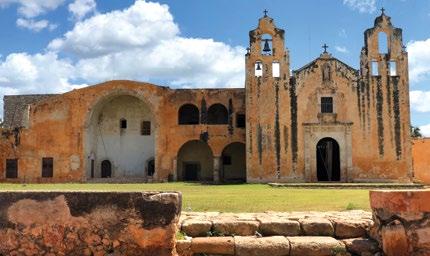
3 minute read
Portada | Cover »
ASTRONOMÍA MAYA
SABIDURÍA ANCESTRAL
Advertisement
Por su parte, Relación de las Cosas de Yucatán, obra escrita por Fray Diego de Landa, y los libros del Chilam Balam, contienen información valiosa y perspectivas de esta rama de la ciencia maya. Los ancestros utilizaron sus conocimientos matemáticos y astronómicos para crear sus calendarios: el Tzolkin y el Haab.
Estos calendarios les permitieron calcular anticipadamente acontecimientos importantes y saber qué omnipresente ser sobrenatural dominaría una fecha determinada. Los aj k´inob (señores de los días por su traducción al español), sacerdotes del calendario, preparaban los rituales que ayudarían a influir de manera positiva en la acción de las fuerzas sobrenaturales sobre los individuos y de la vida comunitaria.
Para realizar sus cálculos, los ancestros recurrieron exclusivamente a los números enteros positivos. Para su representación escrita, los mayas implementaron dos signos: el punto y la barra, que equivalen a 1 y a 5, respectivamente.

Los antepasados desarrollaron sus calendarios basándose en sus observaciones astronómicas durante los amaneceres y los anocheceres para contemplar la aparición y la desaparición de los astros y visualizar al Planeta Venus. Estas observaciones les ayudaron a establecer sus series de días y ciclos que se repetían y se ensamblan entre sí. Los mayas construyeron un observatorio en Chichén Itzá conocido como “El Caracol”, un edificio circular elevado en una plataforma. Cuenta con ventanas que poseen bordes y líneas que permitían la observación astronómica de las posiciones del sol, la luna y las estrellas. Gracias a sus observaciones y creación de sus calendarios, los mayas sabían exactamente cuándo sucedería los equinoccios de primavera y otoño, fenómenos que ocurren en el Castillo de Chichén Itzá y en el Templo de las 7 Muñecas en Dzibilchaltún.
EDITORIAL COMPLETA EN WWW.EXPLORE.MX


MAYA ASTRONOMY, ANCESTRAL WISDOM
The Maya were extremely intelligent in transmitting their mathematical and astronomical knowledge that survives to this day through inscriptions on stone monuments and mate-fold books called “codices.”
At the same time, An Account of the Things of Yucatán, a work written by Diego de Landa, second Bishop of Yucatán, and the Chilam Balam books, contain valuable information and perspectives on this branch of Maya science.
The ancient Maya used their mathematical and astronomical knowledge to create their calendars: The Tzolkin and the Haab. These calendars allowed them to calculate important events in advance and to know which omnipresent supernatural being would dominate a given date. The Aj k’inob (or “Lords of the Days”), priests of the calendar, prepared the rituals that would help to influence in a positive manner supernatural forces on individuals and on community life.
To carry out their calculations, they resorted exclusively to positive integers. For its written representation, the Maya implemented two signs: a dot and the bar, which are equivalent to 1 and 5, respectively.
They developed their calendars based on their astronomical observations during sunrises and sunsets to contemplate the appearance and disappearance of the stars and study Venus. These observations helped them establish their series of days and cycles that repeated and assembled with each other.
The Maya built an observatory at Chichén Itzá known as “El Caracol,” a circular building raised on a platform. It has windows that have edges and lines that allow astronomical observation of the positions of the sun, the moon, and the stars.
Thanks to their observations and creation of their calendars, the Maya knew exactly when the spring and autumn equinoxes would happen, phenomena that occur at the Chichén Itzá Castle and at the Temple of the Seven Dolls in Dzibilchaltún.








